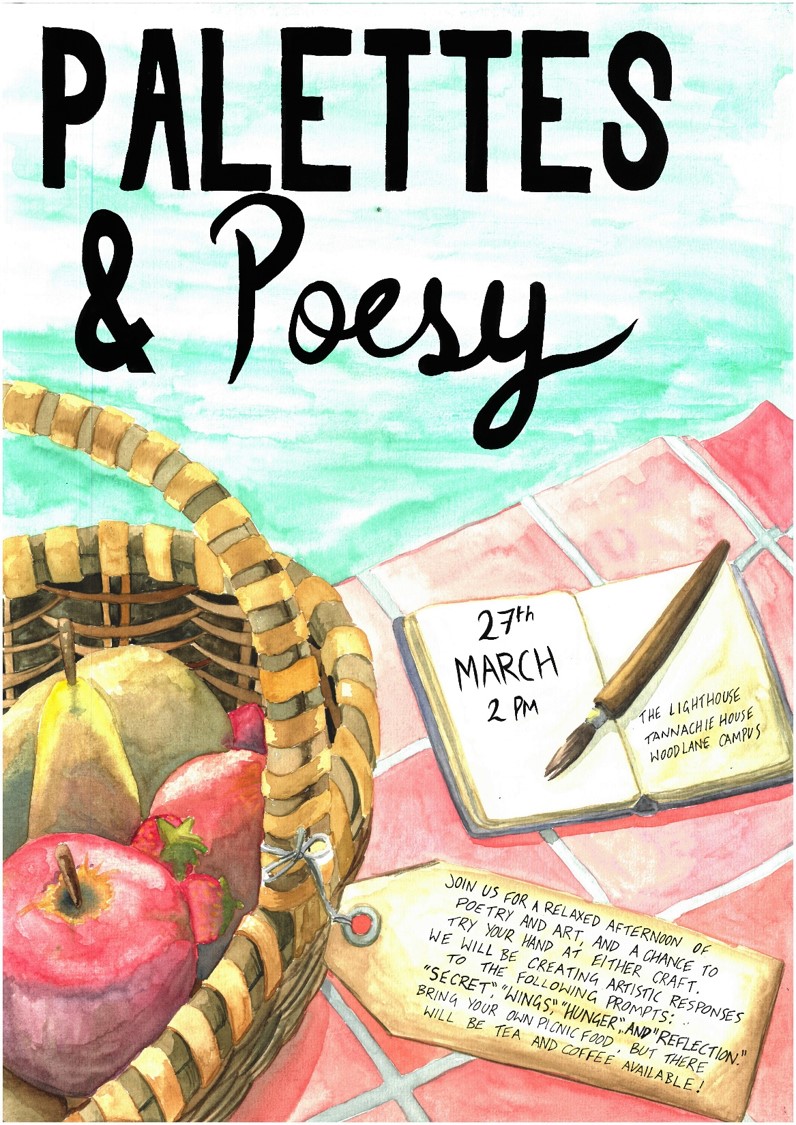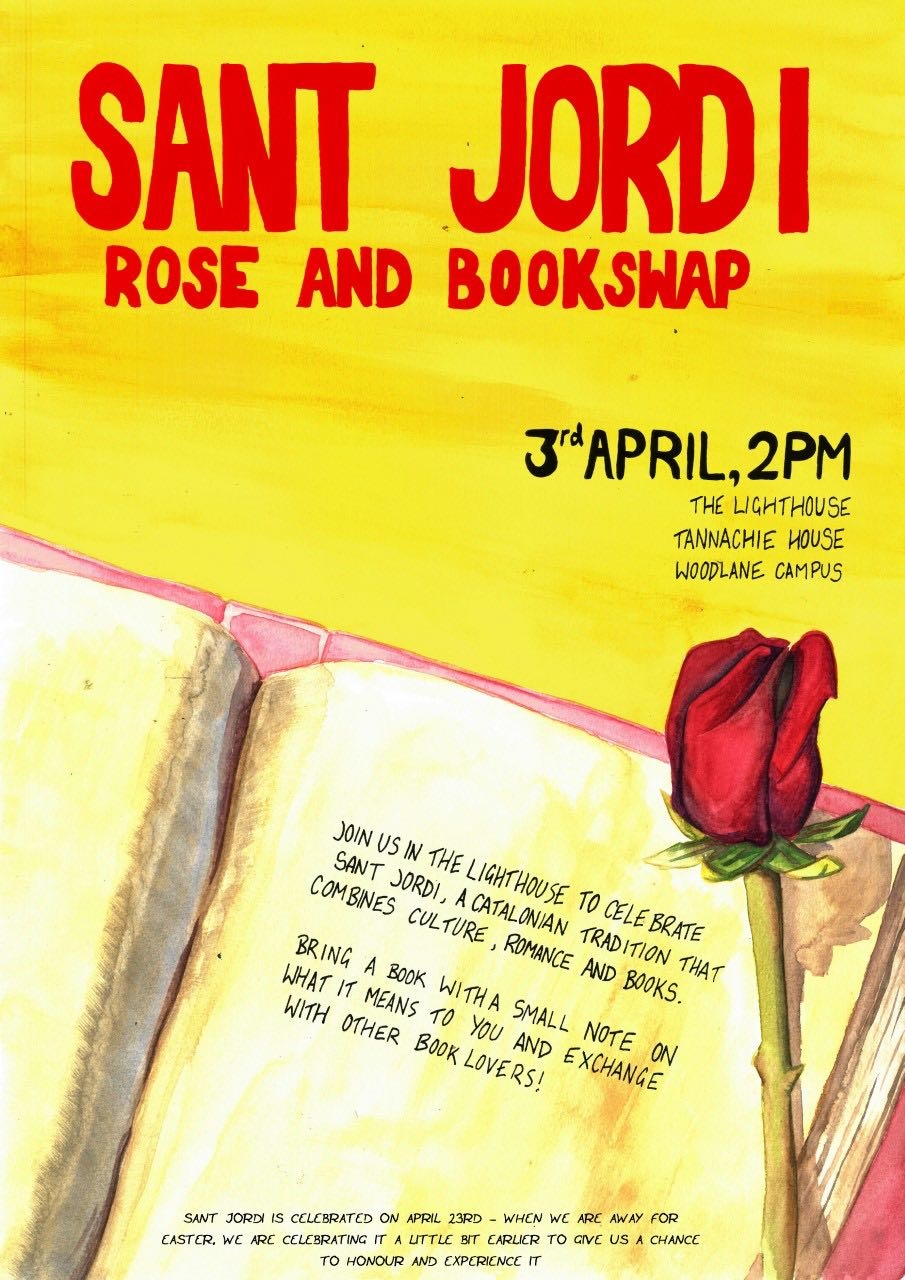Interview with 3rd year Illustration student: Padraig Campbell
Padraig Campbell describes himself as an illustrator who explores “all things dark, weird and spooky”, with an interest in “a great manner of social issues”, all of which manifest in his work. His portfolio includes zines, short comics and book designs, and he is currently working on a graphic novel.
Last term, he collaborated with SOWJ and 3rd years Honeysuckle Troubridge and Max Colbourne to design posters for two literary events, the ‘Palettes & Poesy’ workshop and the Sant Jordi bookswap, both of which took place in the Lighthouse. He was given a short brief on the requirements of the posters and the nature of the events, but the rest was up to his imagination. We can safely say that his final results didn’t disappoint.
Max asked him a few questions about the nature of his work, his influences and his future career in illustration.
What interested you in designing the posters for the SOWJ events? You’d think this was quite an unfamiliar area of work for you.
I think it’s important for any creative individual to branch out and do something a bit different. Throughout the year I’ve just been doing my own thing and setting my own briefs – I’m very independent, so I thought it would be nice for me to take the chance to collaborate with someone. And collaborating with SOWJ seemed like a very interesting venture. And the events themselves – one of them actually is all about collaborating with illustrators, and I thought it would be quite nice to be the person to represent that.
Who are your biggest influences in Illustration?
I’m going to be a bit pretentious and talk about art history – I think the first big artist I was into was Francisco Goya. I got really into his paintings, particularly the Black Paintings, and how they incorporate a lot of supernatural elements with fine art – obviously I’m quite fine art focused, so his Black Paintings were the first foray into supernatural stuff for me.
Also artists like Henry Fuseli, his painting ‘The Nightmare’, and Junji Ito – his comic work is very clever. A lot of European or American comics stick to a grid format, but with Ito, the way he divides up the page to adjust pace and allow for scares is really clever. The way he gels hyperrealism with cartoons is quite jarring and grotesque – it repulses the reader in a beautiful sort of way.
I’ve been raised around Arthur Rackham, because my mum is a big collector of his work, which is also quite sinister – he did the illustrations for Grimms’ Fairy Tales – so having them around the house and walking past them every day has shaped my creative identity in that sense.
Why is paranormal art so important to you? What significance do you think it holds in today’s society?
I think the basic explanation is that my mum is really into ghost stories so I’ve grown up with it. The more in-depth, interesting answer is that the paranormal allows a lot of scope creatively and opens up a lot of doors to talk about various topics. It’s why a lot of horror films hold a lot to unpack underneath the surface, with films like ‘Get Out’, for example. To me it’s a very easy and fun way to discuss things in quite abstract ways. Social commentary is very important to me because it justifies making art and it’s an easy way to become part of the conversation. A lot of people are more open to supernatural content than they are super arty-farty, abstract stuff – horror is the mainstream. So in that sense it’s a really good way to get your point across to a bigger audience. The modern world is also quite scary – fear is very primal but it’s also very prevalent now, and I think it can be quite moving to play with people’s emotions by delving into the weird and creepy.
What advice would you give to an undergraduate beginning BA Illustration?
I think it’s really important to do something you enjoy, because otherwise you’re going to have a miserable time if you try and pander. In first year, I’d say play around and see what aspects of illustration you like – nothing is really cemented until third year, so use the time you have to just find what subject matter you like and don’t feel any rush to nail down your professional identity. Even in third year you’re under no pressure to know what you are – with illustration you’re not going to get a job straight away, so you don’t necessarily need to know that. I would just use it to experiment and find what mediums you like and what ideas you want to get across. I think you’re going to make it really hard for yourself if you try and force yourself into a box.
General uni advice is don’t take any s*** from housemates.
Can you tell us a little bit about your upcoming graphic novel?
So I’m working on my first full-length graphic novel at the minute, it’s called ‘The Dogman of Gasgarth’. Like I said, my work is social commentary and this is also me diving into a topic that’s quite close to me, I guess. As I’ve worked in a lot of shorter mediums, I haven’t been able to explore something in this much depth. It talks about the queer experience at large and how attitudes have boomeranged – I felt personally that things were getting a lot more progressive for LGBT people like myself, but now it feels like we’re slowly reversing and it’s scary to see things being unpicked. I guess that’s what I’m looking into in ‘Dogman’. As a queer person myself and having met so many more queer people since coming to university – back home it was just me feeling practically alone – diving into the community a bit more just made me so hyper-aware of things I’d overlooked before.
At its core, ‘Dogman’ is about two estranged siblings reconciling after a long lapse in their familial relationship, due to the brother having come out as a transgender man and alienated himself from his family. This is him meeting up with his sister for the first time since and trying to bridge the gap that her ignorance has caused. In doing so, he talks about a time from his youth where he and his trans partner go on this summer vacation, but it ends up rather distrastously. We slowly learn about what happened to him when he was a younger man and his absent partner – that’s how I’m sort of unpicking the experience of being a queer person. I think it’s very important that I’ve made my two leads trans men for representation, and even though I don’t have that experience firsthand, I’ve consulted with trans friends and the trans people close to me to make sure that I’m not overstepping my boundaries and that I treat it in a sensitive manner. I think that’s very important in storytelling to tell stories that a) you want to read and b) stories that shine a light on minority groups. I’m not a trans man but I think it’s important to put it in the public eye. I come from a place of privilege and I think it’s everyone’s duty to to use their privilege when they can – I’m quite keen at storytelling, it’s what I want to do, so why shouldn’t I use it as a platform to shine the spotlight on a community that means a lot to me?
What’s in store for your future?
Well I’m currently in the process of moving with my boyfriend back to Plymouth to live with him after we graduate. While I’m working on my graphic novel and a lot of smaller projects, I want to go to some conventions next year to get a table and get my work out there to a bigger audience – it’s all well and good writing these comics but if no one’s reading them they’re not going to any use.
In ten years, I’d like to see myself make a living solely on what I want to do, and not having to work a day job to support my dream. Being optimistic, in ten years’ time I’d like to be scraping by off of making comics, and I’d like to think that I’d have some published works out by then.
Getting into publishing would also be something I’d like to do, besides art. Getting to work behind the scenes would be quite beneficial to me in that regard.
Anything we should look out for in the meantime?
Well, funnily enough, I’ve just self-published my first anthology called ‘Upwards Incursion’. It collects three short comics I’ve been working on in the last year – they’re all a bit abstract but very social commentary focused. You can buy it from my shop which is linked on my website – it’s £3 with £1 postage, a pretty sweet deal, I think. I aim to get a second issue out in the near future.
It was a pleasure to work with Padraig and learn more about the creative processes of an illustrator. It was a joyous collaboration across two courses that we’ll never forget.
Padraig can be found at padraigcampbell.com, where you can buy “Upwards Incursion”, or on Instagram as @upwards.incursion.
by Max Colbourne



